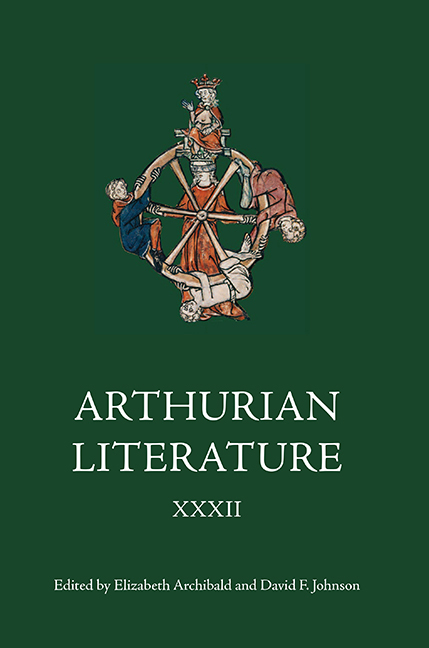Book contents
- Frontmatter
- Contents
- List of Illustrations
- General Editors’ Foreword
- List of Contributors
- I Wounded Bodies: Kingship, National Identity and Illegitimate Torture in the English Arthurian Tradition
- II The Place of Emotion: Space, Silence and Interiority in the Stanzaic Morte Arthur
- III Another Source for Malory’s ‘Tale of Sir Gareth’
- IV ‘Warre and Worshyppe’: Depictions of Battle in Malory’s Le Morte Darthur
- V Malory’s ‘Chivalric Cliques’: Public and Private Felyshyp in the Arthurian Community
- VI Scribal Modifications to Concluding Formulae in the Winchester Manuscript
- VII Heraldic Imagery in the Embroidered Tristan Narratives
- VIII Update to the List of Manuscripts of Geoffrey of Monmouth’s Historia Regum Britanniae
- Contents of Previous Volumes
General Editors’ Foreword
Published online by Cambridge University Press: 11 May 2021
- Frontmatter
- Contents
- List of Illustrations
- General Editors’ Foreword
- List of Contributors
- I Wounded Bodies: Kingship, National Identity and Illegitimate Torture in the English Arthurian Tradition
- II The Place of Emotion: Space, Silence and Interiority in the Stanzaic Morte Arthur
- III Another Source for Malory’s ‘Tale of Sir Gareth’
- IV ‘Warre and Worshyppe’: Depictions of Battle in Malory’s Le Morte Darthur
- V Malory’s ‘Chivalric Cliques’: Public and Private Felyshyp in the Arthurian Community
- VI Scribal Modifications to Concluding Formulae in the Winchester Manuscript
- VII Heraldic Imagery in the Embroidered Tristan Narratives
- VIII Update to the List of Manuscripts of Geoffrey of Monmouth’s Historia Regum Britanniae
- Contents of Previous Volumes
Summary
This volume of Arthurian Literature puts considerable emphasis on Arthurian narratives in material culture and historical context, as well as on purely literary analysis. It begins with Larissa Tracy's wide-ranging study of torture in relation to texts from Chrétien to Malory, by way of the Stanzaic Morte Arthur and Arthur and Gorlagon. She argues, with a wealth of fascinating evidence, that the inclusion or omission of torture in English texts reflects particular attitudes to the use of torture in English law and society, which related to a sense of national identity. The Stanzaic Morte has been undeservedly neglected: Marco Nievergelt's study of emotion in relation to space in the poem indicates a very subtle attitude on the part of the writer to subjectivity and interiority, and will encourage much re-reading of one of Malory's key sources. Ralph Norris, who has produced a valuable study of Malory's library, addresses the question of the originality of ‘The Tale of Sir Gareth’: he accepts the theory that it is by Malory, but points out striking parallels with the Knight of the Cart story as found in Chrétien and in some versions of the French prose Lancelot. This essay throws new light not only on the source(s) of the Gareth tale but also on the popular Fair Unknown theme. The next two essays also focus on Malory, addressing two central themes in his work: battle and fellowship. Lisa Robeson discusses battle scenes, arguing that they ‘offer not only a lesson in chivalry but in chivalric kingship’, and that chivalry must be embodied in the person of the king as well as in great knights such as Lancelot. Richard Sévère considers Arthurian fellowship in Malory through the lens of Cicero's comments on friendship in the very influential De amicitia; he emphasises both the comfort of fellowship and its dangers for the Arthurian world.
The last three essays scrutinise selected Arthurian narratives very closely in their original material forms, rather than modern versions. David Eugene Clark analyses concluding formulae in the Winchester manuscript of Malory's Morte Darthur, comparing them with Caxton's printed version; he uses his findings to argue that scribes made numerous and significant changes to the structure and division of Malory's text, sometimes blurring the distinctions between larger and smaller narrative sections.
- Type
- Chapter
- Information
- Arthurian Literature XXXII , pp. vii - viiiPublisher: Boydell & BrewerPrint publication year: 2015

